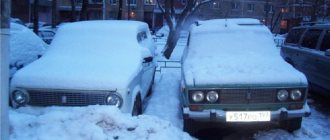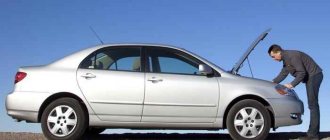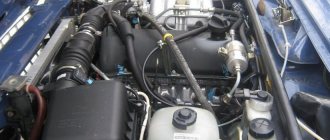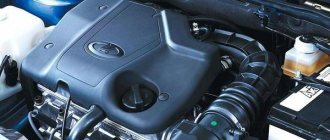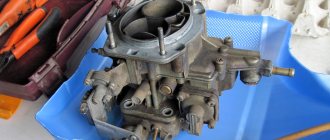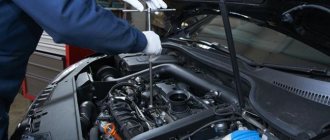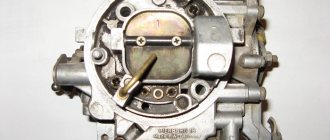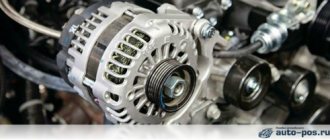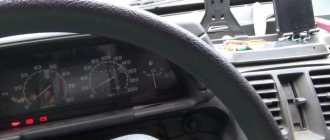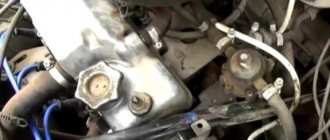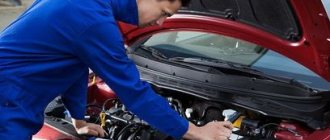Fuel quality
One of the reasons is low quality gasoline, which does not meet the octane requirements for the car. The driver needs to remember where and what kind of gasoline the vehicle was last filled with. If it is indicated that the motor should run on AI-95 or AI-98, pouring AI-92 into the tank is dangerous.
The problem is caused by fuel - when you press the gas pedal fully, the speed does not pick up, and when the clutch is depressed, the power unit stalls. The situation is explained by the weak spark produced by poor fuel.
To fix the problem you need to:
- Drain fuel.
- Wash the motor.
- Clean all fuel system pipes.
- Change the fuel filter.
Car engines are sensitive to fuel quality.
Fifth reason – Low fuel pressure
If your car stalls while driving up or down hills, the problem may be low fuel pressure. If this problem occurs, your machine will not operate reliably.
Generally, the car can start and drive easily on level roads, but will likely stall when going uphill due to low fuel pressure. Fortunately, this is one of the simplest problems; to fix it, try adding a little injector cleaner to the fuel tank.
[custom_ads_shortcode1]
Spark plug
The car stalls while driving due to spark plugs: clogged contacts, plaque formation, incorrect voltage supply.
If a black coating appears on the spark plugs, a normal spark will not be able to form. The presence of dirt on the contacts indicates low quality fuel. The contamination is caused by a defect in the oil supply system.
A black coating appears on the candles
Oil on the spark plugs is a sign of failure. The car must be sent for diagnostics. Ignoring a problem can lead to costly repairs.
Attention! When the spark plugs fail, the engine runs unevenly, the car jerks when driving, periodically stalls, and is difficult to start. If there is a red-brown coating on the contacts, low-quality fuel is poured into the tank. In this case, the spark plugs need to be replaced.
First reason – Generator malfunction
Alternator failure is one of the most common reasons why a car stalls while driving. Most drivers believe that if the generator fails, the car will not start. In practice, everything is a little different, if the battery is charged, your car can be started, and it will work even with a faulty generator.
The thing is that at this moment the car is powered not by the generator, but by the battery. But this will ultimately lead to the car stalling at the most inopportune moment and no longer starting due to the low battery charge.
Checking the battery charge level is very simple using a voltmeter. The check should be carried out with the engine turned off and the headlights off. Open the hood and connect a voltmeter to the battery terminals. To do this, the positive terminal of the voltmeter must be connected to the positive terminal of the battery, the negative terminal to the negative terminal.
Remember that fully charged car batteries should read 12.66 volts.
[custom_ads_shortcode3]
Throttle valve
The cause of the breakdown is contamination of the throttle valve. The car's response to the gas pedal is late, the speed is uneven, the engine stalls, the part needs to be washed. Necessary:
- Buy a special product at a car store.
- Remove the damper.
- Rinse thoroughly.
- Install back.
If these steps do not help, the problem is related to the power supply (see below).
On foreign-made cars, the throttle damper could fail. Then, when you release the gas, the engine will stall. The part is responsible for returning the damper to its normal position, eliminating dips.
To check the damper you need:
- Warm up the engine to operating temperature.
- Open the valve yourself.
- Let go quickly.
The part should return almost to the limit, pause and not reach the end so quickly. If no deceleration is observed, the damper is faulty. It needs to be replaced, repair is impossible.
Throttle valve dirty.
Recommendations
So, the car stalled while driving, what to do next:
- Using the inertia of movement, push the car off the roadway, no matter whether it is a city road or a highway.
- Turn on the alarm.
- It is mandatory to install an emergency sign at the back of the car: there are plenty of fans of high-speed driving everywhere, there is no need to create an emergency situation.
- Put the car on the handbrake.
Option 2 for further developments:
- Do the repairs yourself.
- Find a way to transport the car to the service.
In order to avoid such unpleasant and unexpected moments when the car stalls while driving, you need to follow simple rules:
- Carry out vehicle diagnostics at a service center as often as possible.
- Carry out preventive maintenance and inspection of the machine yourself.
- Monitor the condition of parts and replace them in a timely manner so that the machine does not break down in unexpected places.
You should always have a tool with you to repair minor damage, as well as a can of gasoline to avoid stopping due to its absence.
As a rule, the true cause of the breakdown is revealed quite simply. And even a car owner who does not have deep knowledge of vehicle repair can easily correct problems that arise that are accompanied by incorrect behavior of his car.
Idle speed control
On VAZ models with an engine of 8 or 16 valves and on foreign cars, the power unit starts up, then stalls due to IAC. The wrong name is idle speed sensor, the correct name is regulator.
The device monitors engine speed and maintains it. At idle, the engine stops working, or uneven speed is observed - the part is faulty. When the gearbox is switched to neutral, the engine stalls - it is worth changing the regulator.
Sometimes similar symptoms are observed when the throttle valve is dirty. It is recommended to clean it first.
Injection engines
If a car with an injection engine stalls while driving, then there may be several problems of this kind:
- The oxygen enrichment system for the fuel mixture is faulty.
- Broken oxygen sensor.
- The intake manifold is malfunctioning.
- Fuel injectors are partially or completely dirty.
- The cooling system of the unit is broken.
If the owner himself is not sure of the cause of the breakdown, the same diagnostics are needed, after which repairs are already carried out. You can describe some of the reasons in more detail, but do not forget that there can be a lot of them, and they are all different - it depends on the make of the car, the country of origin, the type of engine, etc.
[custom_ads_shortcode2]
Air filter
Replacing filters in a car is an important maintenance procedure that many people forget about. As a result, the filter becomes clogged and the operation of the power unit and systems is disrupted. If there is severe contamination or damage, the engine will run unevenly and jerkily—it will stall when you press or release the gas pedal.
Attention! The engine stalls in the same way if the XX regulator fails.
To verify the malfunction, you need to dismantle the filter and inspect for damage. If dirty or worn, replacement is necessary.
Clogged air filter
Weather
The reason for the unstable operation of the engine at idle also includes weather conditions. Very often the power unit stalls when trying to warm up the car in cold weather, which makes this process much more difficult.
So, for example, a gas-powered car stalls at idle due to freezing of the gas in the gearbox. This happens if you warm up the engine not on gasoline, but directly on gas. The gas reducer is heated and connected to the cooling system. Since the unit itself is still cold, and the gas entering the reducer tends to cool when the pressure changes, icing and clogging of the gas pipeline elements and reducer parts occurs. It is this factor that does not allow the engine to idle steadily and without stopping.
To prevent freezing and trouble-free warm-up, the engine must be heated with gasoline until the coolant temperature rises. Craftsmen have adapted to warm up the gas reducer with hot water from a kettle before starting the engine. This prevents premature freezing of gas equipment elements before the engine has already warmed up.
Fuel filter
A dirty fuel filter is another reason why your car stalls when driving. The part is installed on all vehicles. The problem with the device occurs among owners of used cars. The filter is forgotten and rarely changed.
Over time, the dirt fills up, it is difficult for gasoline to pass into the ramp, and there is no combustion chamber. Fuel will arrive intermittently, and then may not arrive. If the filter is clogged, the car stalls when you press the gas pedal.
You need to dismantle the fuel pump, remove the filter and install a new one. There is no point in cleaning it - the cost of the part is small.
Additionally
- Brake malfunction. In this case, the design of the vacuum booster is usually faulty. The problem comes to light when braking hard - resulting in a stalled engine (i.e. it slowly stalls on its own). Usually the entire amplifier is replaced or its adjustment is made.
- Exhaust system. The exhaust system may be contaminated, and after such contamination the car simply cannot “spit out” all the accumulated gas and begins to “choke.” It is necessary to clean the muffler; if the problem is not only contamination, but also a breakdown of the catalyst, the exhaust system must be completely replaced.
Is it due to poor fuel quality? Often the problem is precisely the fuel of low quality, or that does not correspond to the brand of car the driver is driving.
Gas stations need to be carefully monitored. Fuel tends to pollute and contribute to the rapid wear of many vital parts for a car.
When using low-quality mixtures, the following occurs:
- Rapid contamination of the fuel filter.
- Malfunctions appear in the operation of the injection nozzles.
- Throttle valves become dirty quickly.
- The fuel pump is not working properly.
The most important indicator of a malfunction is a gradual decrease in engine power, as a result of which the car will stall even when the gas pedal is sharply pressed. Many problems can be identified yourself without spending extra money to pay for the services of a service center, but if the problem is not eliminated during an external inspection and subsequent repair of fuel systems, you will have to conduct computer diagnostics to more fully and deeply identify problems.
If your car has an automatic transmission and the car periodically stalls while driving, then the problem is usually in the power supply.
When the transmission changes gear, the computer receives a notification that some part is faulty and decides to immediately turn off the engine. Problems with this type of car must be resolved as quickly as possible; repairs must be carried out only by specialists. Personal interference will lead to an even bigger problem.
[custom_ads_shortcode1]
Fuel pump
Due to a faulty fuel pump, the car may operate normally for a while, then stall. Interruptions begin in the mechanism, fuel does not enter the chambers or arrives in small quantities. Initially, the engine will run at idle, as the speed increases, it will stall, and when the pump finally fails, it will not start.
The fuel pump is easy to repair, but the breakdown may recur, so it is better to replace it. This unit is located under the rear seat.
In summer, the fuel pump may operate intermittently due to fuel boiling. This happens on classic Soviet cars. To get rid of the problem, you have to turn off the engine and wait until the fuel cools down.
Catalyst
A clogged and faulty catalyst can also affect engine performance. Determining whether the catalyst is clogged or not is quite simple. To do this, you need to warm up the engine well, preferably at high speeds. Then, from the inspection ditch, inspect the device without using additional lighting - if it glows, this means that it is dirty and does not pass exhaust gases through well.
When a car stalls while driving, then, for example), problems may be hidden in the exhaust gas recirculation valve (error P1406). If the exhaust gas valve is stuck in the slightly open position, the engine will not develop full power and may stall at low speeds. When, on the contrary, it is closed all the time, then at high speeds the engine will operate unstably and detonate.
Electrical problems
The car engine stops running while driving due to electrical problems. Initially, you need to check all the masses.
The battery terminals may not be secure enough; if the connection is poor, no power will be supplied; this is a rare problem.
You need to check the generator connections. After repairs, the repairman may forget to tighten the terminals, and the device will not charge. The battery will be completely discharged and the engine will stall while driving. The location of the generator for the VAZ-2115, 2110 and 2112 models is similar.
The generator could fail or the belt could break. This is indicated by an icon on the dashboard. It is recommended to visit a car service; repairing it yourself can be harmful.
You should check the ground that goes from the negative of the automatic transmission to the engine. For prevention, the terminals are cleaned and lubricated with a special compound.
The reason is faulty high-voltage wires. Can't be repaired - needs to be replaced.
Faulty ignition coil
When the ignition coil is not functioning, the engine periodically stalls. There is increased fuel consumption, a drop in vehicle power, and poor engine starting.
The power unit begins to “triple”, especially in the rain, the speed is uneven. A breakdown is indicated by an indicator on the dashboard.
To verify that the coil is faulty, you must:
- When “triple” occurs, remove one coil at a time. If you remove the good one, the speed will begin to “float” more; eliminating the faulty one will not change anything.
- If the part does not function, the spark plug will be wet, with a black coating, and the resistance will differ.
Attention! VAZ cars with an 8-valve engine have an ignition module, the role of which is similar to that of coils.
Vacuum brake booster
The power unit stops working when you press the brake - the problem is in the vacuum booster. The device is connected by a hose to the intake manifold.
A faulty membrane cannot create a vacuum at the right moment when you press the brake pedal. Air flows enter the working mixture, which becomes lean. The engine cannot run on such a mixture, so it stalls.
To fix the problem, it is enough to change the gaskets and membrane, and sometimes the hose.
Faulty air duct corrugation
On cars with an injector engine, the cause of the problem may be a depressurized (usually torn) air duct corrugation. Air flows past the mass air flow sensor, incorrect information is sent to the control unit, the mixture changes, and the engine stops working.
The engine “troits” even at idle. To eliminate the breakdown, it is enough to change the corrugation.
Lambda probe
The sensor is necessary to analyze the oxygen content in the exhaust gases and check the quality of the mixture. Failure of the device is the reason for poor engine starting, interruption of operation and reduction in power. Fuel consumption also increases. You can verify that the problem is related to the device by performing diagnostics.
Faulty Lambda probe
Sensors
Cars have many sensors. If one breaks down, the vehicle begins to act up, the engine may “trouble.”
Often the engine stops working due to the crankshaft timing sensor. If the part fails completely, the car will not start. Due to problems in the device, the power unit will operate unevenly and periodically stall.
The sensor may overheat.
Illiterate firmware
Car owners often have their vehicles flashed. This procedure allows you to unlock the potential of the engine and improve dynamics.
In order to save money, car enthusiasts make the firmware cheaper. As a result, the car goes further faster and stalls when the speed drops. The control unit confuses the readings and supplies the working mixture in different ways.
It's worth resetting to factory settings. When flashing, you need to choose a good specialist with extensive experience - incorrect settings can cause great harm.
The car stalls while driving, then starts. Possible causes, elimination
Stas [stas90]
08/17/2017, Views: 146561
Often car owners are faced with a very unpleasant problem: the car suddenly stalls while driving. Then immediately, perhaps after a certain time, it starts up again and drives as if nothing had happened. Such faults at service stations belong to the class of flickering faults; many workshops charge double the cost for their repair. And this is understandable: it can be difficult to detect. After all, as a rule, the so-called general effect works here in reverse. If an auto electrician comes to such a call, the car starts up as if nothing had happened and works until the technician leaves. I myself have found myself in such situations more than once. First, let's figure out, in general, what is needed for the engine to work.
Conditions for normal engine operation
For stable operation, internal combustion engines require:
- constant injection of air, and in proportions corresponding to the fuel;
- optimal pressure in the ramp;
- normally working nozzles (injectors);
- correct ignition angle;
- serviceable sensors and actuators of the engine control unit;
- required compression;
- in gasoline cars - plus an ignition spark.
In motorist parlance, an engine needs air, fuel, compression and ignition.
From the point of view of the likelihood of failure of the internal combustion engine, gasoline engines are more vulnerable, because they have an additional system - a high-voltage ignition unit, which is very sensitive to operating weather conditions. Drivers know that once a diesel engine is started, it can “burb” all day long, although not always.
Why does it happen that a car stalls and then starts? The most likely causes of this malfunction include:
1. Immobilizer problems
An immobilizer poses a great danger to most motorists. And this is understandable: you can’t deal with it without special equipment, and the services of auto electricians to fix problems with the immobilizer are expensive. If for some reason the immobilizer blocks the engine control unit, then different car models behave differently. In BMW, if there are problems with the immobilizer, the starter usually does not even spin; most models allow you to try to start it. But in Renault, as in some other models, the engine usually starts, but after a few seconds it stalls. Then it starts again, and after the same time it stalls. This can go on indefinitely.
Immobilizer synchronization failure occurs for the following reasons:
- use of a non-original key or loss of a chip from it;
- battery discharge in the key, if the circuit provides power to the chip;
- breakage of the pumping loop (located in the area of the lock cylinder);
- failures of car alarms with auto start (transponder);
- Malfunctions in the power supply circuits of the engine control unit, immo.
Just in case, you can check if your key has a chip.
If your car has an on-board computer, an immobilizer failure will be indicated in the form of a message such as IMMO or SECRET SERVICE, KEY or a blinking yellow LED. It should be remembered that if you started the car and drove it a few hundred meters, the immobilizer has already synchronized with the engine control unit, its sudden stop will in no way be related to this problem. That is: stopping the engine while driving is not an immobilizer problem!
2. Crankshaft sensor malfunction
It is responsible for overall ignition timing in both gasoline and diesel engines. If the sensor is faulty, then in 95% of cases the car will not start at all. But if the sensor is on the verge of its performance, then the engine may fail. The fact is that the sensor is usually electromagnetic. It represents an inductor wound with an extremely thin wire around a magnetic core. During use and wear, moisture may enter it. When the engine heats up while driving, the sensor coils may open and the engine stalls. Then, while you are struggling to start it, the engine cools down, the sensor coils close again, and the car starts up as if it should. So: a typical situation for a faulty crankshaft sensor: the engine starts when cold without problems, after 15 minutes of driving it suddenly stalls, then, after you wander around the car for half an hour, it starts again without problems. Advice for car enthusiasts - moisten a rag with cold water and place it on the sensor. Somehow you will get home while the sensor is cooling.
By the way, this malfunction may not be diagnosed when it is cold.
3. Flow meter malfunction
This sensor is involved in the quality formation of the mixture. If the flow meter is clogged (this often happens on run-down engines, it becomes clogged with oil), the mixture is formed enriched, it can flood the spark plugs. At idle speed in traffic jams or when coasting, this can cause the engine to stall. Then the engine starts with difficulty again, and so on. You can try cleaning the flow meter with carburetor cleaner. Many car enthusiasts turn it off altogether and, if the car stops stalling, they drive like this for a couple of years.
Installing a new flow meter to replace a heavily contaminated old one solves the problem for a short time. If the piston group or valve stem seals are very worn, the sensor will soon become dirty again.
4. Ignition system for gasoline internal combustion engines
If one of the spark plugs floods or one of the high-voltage wires breaks, the engine usually does not stop. But if the ignition coil (if it is single or double) breaks down when heated, then the car may periodically stall, then start again after a while. Sometimes the coil has microcracks. In wet weather, moisture can get in there and the car may stop suddenly. Sometimes during a rainstorm or if it gets into a puddle, the ignition system becomes flooded with rainwater. Then, as it dries, everything returns to normal. There is only one way to check the ignition coil: throw in a known good one, because a broken coil can ring normally using a multimeter.
5. Idle speed control
If the idle speed is not adjusted correctly, or the governor drive is stuck, the engine may stop at idle speed. You can try cleaning bypass regulators and regulators with stepper motors.
6. Air leak
Usually leads to uneven operation of the engine, which may stall when the accelerator pedal is suddenly moved. Many service stations use smoke machines to search for leaks. Experienced mechanics use a good cigarette.
7. High pressure pump wear
If you suspect the fuel pump, it is better to remove it and take it for diagnostics.
8. Low pressure in the ramp
Typically, engine shutdown occurs due to the fault of the electronic valve pressure regulator installed in the fuel pump. As a rule, flushing the valve does nothing.
9. Fuel pump wear
In many situations, the fuel pump remains in visually working condition, that is, it seems to be pumping. But its productivity and pressure drop to critical levels. The impeller begins to pump, then the pressure decreases by an order of magnitude. The car keeps moving and then shuts up. Change the fuel pump without question. Now the pumps themselves are inexpensive, they can be replaced without equipment, which costs money.
10. Car alarm failures
Frequent malfunction. If the alarm is installed by a non-professional, even worse, in garages, it may begin to fail immediately. After 7 years of operation, all alarms begin to fail. Typically, alarm systems use fuel pump circuits to block theft. If the signal fails, fuel is cut off. Nowadays it has generally become fashionable not to install alarms, but to turn them off. There are more and more such calls to service stations. Advice: install alarms only at proven service stations, otherwise you won’t find anything in a couple of years; When buying a used car, find out the coordinates of who installed the car alarm.
If your car begins to periodically stall while driving, then start, immediately solve the problem, determine the cause of the problem and fix it. Otherwise, sooner or later it will stall for a long time.
Read about troubleshooting other problems on my blog.
